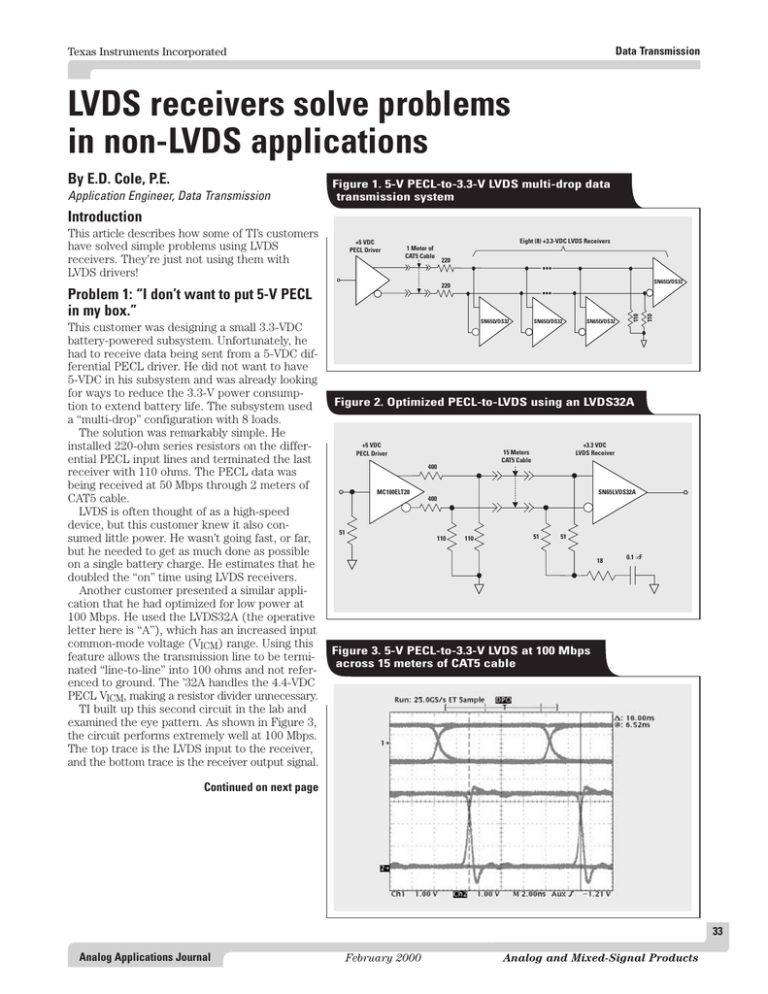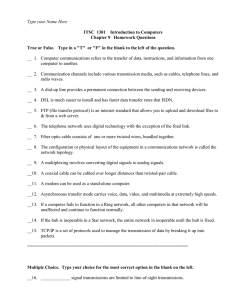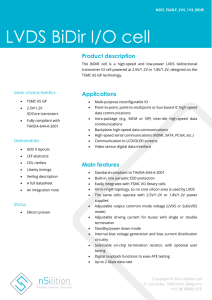LVDS receivers solve problems in non-LVDS
advertisement

Data Transmission Texas Instruments Incorporated LVDS receivers solve problems in non-LVDS applications By E.D. Cole, P.E. Application Engineer, Data Transmission Figure 1. 5-V PECL-to-3.3-V LVDS multi-drop data transmission system Introduction This article describes how some of TI’s customers have solved simple problems using LVDS receivers. They’re just not using them with LVDS drivers! +5 VDC PECL Driver Eight (8) +3.3-VDC LVDS Receivers 1 Meter of CAT5 Cable SN65LVDS32 SN65LVDS32 SN65LVDS32 110 SN65LVDS32 110 220 Problem 1: “I don’t want to put 5-V PECL in my box.” This customer was designing a small 3.3-VDC battery-powered subsystem. Unfortunately, he had to receive data being sent from a 5-VDC differential PECL driver. He did not want to have 5-VDC in his subsystem and was already looking for ways to reduce the 3.3-V power consumption to extend battery life. The subsystem used a “multi-drop” configuration with 8 loads. The solution was remarkably simple. He installed 220-ohm series resistors on the differential PECL input lines and terminated the last receiver with 110 ohms. The PECL data was being received at 50 Mbps through 2 meters of CAT5 cable. LVDS is often thought of as a high-speed device, but this customer knew it also consumed little power. He wasn’t going fast, or far, but he needed to get as much done as possible on a single battery charge. He estimates that he doubled the “on” time using LVDS receivers. Another customer presented a similar application that he had optimized for low power at 100 Mbps. He used the LVDS32A (the operative letter here is “A”), which has an increased input common-mode voltage (VICM) range. Using this feature allows the transmission line to be terminated “line-to-line” into 100 ohms and not referenced to ground. The ’32A handles the 4.4-VDC PECL VICM, making a resistor divider unnecessary. TI built up this second circuit in the lab and examined the eye pattern. As shown in Figure 3, the circuit performs extremely well at 100 Mbps. The top trace is the LVDS input to the receiver, and the bottom trace is the receiver output signal. 220 Figure 2. Optimized PECL-to-LVDS using an LVDS32A +5 VDC PECL Driver +3.3 VDC LVDS Receiver 15 Meters CAT5 Cable 400 MC100ELT28 SN65LVDS32A 400 51 110 110 51 51 18 0.1 µF Figure 3. 5-V PECL-to-3.3-V LVDS at 100 Mbps across 15 meters of CAT5 cable Continued on next page 33 Analog Applications Journal February 2000 Analog and Mixed-Signal Products Data Transmission Texas Instruments Incorporated Continued from previous page It was obvious that the signaling rate could be increased, so this was run at 200 Mbps and 300 Mbps. The waveforms at 300 Mbps are presented in Figure 4. The top trace in Figure 4 is the input signal to the LVDS receiver. The bottom trace is the output of the LVDS32A receiver. The cable effects become evident at the higher signaling rates, and the signal degrades rapidly after 330 Mbps. LVDS is used not only for high-speed but often for lowpower applications as well. Figure 4. 5-V PECL-to-3.3-V LVDS32A at 300 Mbps across 15 meters of CAT5 cable Problem 2: “The output from my crystal doesn’t look very good!” (or “My processor board seems to work better when the clock has edges.”) Another customer found that the output signal from his crystal oscillator needed to be “cleaned up” and distributed across a processor motherboard. His prior solutions had used a Schmitt trigger. Depending upon which oscillator he used, he sometimes used a transformer before the Schmitt trigger to boost and shift the input level to the Schmitt trigger. He had an unused receiver in a LVDM180 transceiver and now uses it to “clean up his clock,” as shown in Figure 5. This customer has several interesting LVDS applications on his processor board. This one caught the author’s eye because it’s so simple. The customer realized that an LVDS receiver is a very high-speed comparator, and that’s exactly what he wanted. He said that this circuit gives him faster edges, uses less power, reduces his parts count, and is less expensive. This circuit was tried in the lab with several different crystals (the author even tried it with an LC tank circuit). We found that R2 had to be replaced with a 10-kohm potentiometer because different oscillators had different output waveforms. Adjusting R2 made the duty cycle variable over a very wide range. Results obtained from a 100-MHz crystal are shown in Figure 6. The circuit was constructed with the crystal output connected to the inverting input pin on the LVDM180 (pin 11) instead of to the non-inverting input (pin 12). If your CLK looks a little like a sine wave, give this a try. The author was impressed. Problem 3: “Can I use LVDS to receive highspeed 5-V CMOS data?” Figure 5. Using an LVDS receiver as a highspeed comparator 3.3 V R1 10 k VCC EN 14 12 OUT 11 80-MHz OSC R2 2.2 k A B 7 LVDM 180 2 RE R 3 Figure 6. Using an LVDS receiver to improve the edges of an oscillator A customer asked if he could use LVDS to receive highspeed digital video through 10 meters of CAT5 cable. The driver was a single-ended, high-speed 5-V CMOS driver. He mentioned that the video was streaming at 300 Mbps. He did not know the specific part number of the driver, and he said he “could live with a few errors” since it was video. One solution was to provide him with the schematic shown in Figure 7. The SN54AHC04 hex inverter was selected as the 5-V CMOS driver along with Belden’s MediatwistTM cable (because that’s what was on hand). At 300 Mbps, impedances have to be matched, so the termination scheme was optimized to 100 ohms, and values were selected that would divide the input signal down to the nominal input range (VICM approximately 1.2 VDC) of the LVDS receiver. Note that this scheme creates the differential input at the receiver by bringing the driver 34 Analog and Mixed-Signal Products February 2000 Analog Applications Journal Data Transmission Texas Instruments Incorporated ground through the cable. In the actual appliFigure 7. 5-V high-speed CMOS-to-LVDS receiver cation, a system ground would be required between the driver supply and receiver supply +5 VDC to minimize any ground potential difference +3.3 VDC +5 VDC CMOS (VGPD) between driver and receiver. Driver +3.3 VDC 8.6 k The waveforms shown in Figure 8 verify that 10 Meters of LVDS CAT5 Cable 66 the customer could use an LVDS receiver to Receiver receive his video data. The top waveform is the SN74AHC04 digital video signal at the input pin of the SN65LVDS32A LVDS32. The bottom waveform is the output 51 signal from the receiver. The customer said he “could live with a few 0.1 errors,” so a bit-error-rate (BER) test was per33 formed to see how fast this circuit would go before VCC = +5.00 VDC 1.5 k VIH = +4.50 VDC serious errors occurred. . The test set pattern VIL = +0.50 VDC generator in the BER tester can output only a maximum VIH of 2.0 VDC, which would cause errors if the AHC04 VCC remained at 5.0 V. Fortunately, the AHC04 inverter operates with VCC = 2.5 V to 5 V, so VCC was adjusted to 3.3 VDC, and the BER test was run with VIH = 2.0 VDC and VIL = 1.2 VDC. The test started at Figure 8. Single-ended 5-V CMOS driver into 400 Mbps, and the BER was recorded. The signaling rate an LVDS receiver through 10 meters of CAT5 was decreased in 10-Mbps steps, and the test was repeated. cable at 300 Mbps This process was continued until no errors were received at 340 Mbps. The BER results are shown in Figure 9. The test continued to run, but at 350 Mbps the error rate was 10–13, which equates to 1 bit error in every 10 trillion bits. This would be great since “it’s just video.” Also, the test time increases as the errors decrease. For example, at 300 Mbps it takes 9.25 hours to transmit 10 trillion (1013) bits, so testing for error rates of 10–15 or 10–16 takes days to complete. But it’s better now than it was— before LVDS, these BER tests were run at 50 Mbps and would take 23 days! Conclusion This article has demonstrated that an LVDS driver does not always have to be connected to an LVDS receiver. The latter works quite well with other types of drivers, as these customers have demonstrated. Related Web sites analog.ti.com interface.ti.com Figure 9. Bit error rate vs. signaling rate Error Rate Get product data sheets at: www.ti.com/sc/docs/products/analog/ device.html Replace device with sn65lvdm180, sn65lvds31, or sn65lvds32a www.ti.com/sc/docs/products/logic/ sn54ahc04.html 10 –1 10 –3 10 –5 10 –7 10 –9 10 –11 10 –13 340 350 360 370 380 Signaling Rate (Mbps) 390 400 35 Analog Applications Journal February 2000 Analog and Mixed-Signal Products IMPORTANT NOTICE Texas Instruments Incorporated and its subsidiaries (TI) reserve the right to make corrections, modifications, enhancements, improvements, and other changes to its products and services at any time and to discontinue any product or service without notice. Customers should obtain the latest relevant information before placing orders and should verify that such information is current and complete. All products are sold subject to TI's terms and conditions of sale supplied at the time of order acknowledgment. TI warrants performance of its hardware products to the specifications applicable at the time of sale in accordance with TI's standard warranty. Testing and other quality control techniques are used to the extent TI deems necessary to support this warranty. Except where mandated by government requirements, testing of all parameters of each product is not necessarily performed. TI assumes no liability for applications assistance or customer product design. Customers are responsible for their products and applications using TI components. To minimize the risks associated with customer products and applications, customers should provide adequate design and operating safeguards. TI does not warrant or represent that any license, either express or implied, is granted under any TI patent right, copyright, mask work right, or other TI intellectual property right relating to any combination, machine, or process in which TI products or services are used. Information published by TI regarding third-party products or services does not constitute a license from TI to use such products or services or a warranty or endorsement thereof. Use of such information may require a license from a third party under the patents or other intellectual property of the third party, or a license from TI under the patents or other intellectual property of TI. Reproduction of information in TI data books or data sheets is permissible only if reproduction is without alteration and is accompanied by all associated warranties, conditions, limitations, and notices. Reproduction of this information with alteration is an unfair and deceptive business practice. TI is not responsible or liable for such altered documentation. Resale of TI products or services with statements different from or beyond the parameters stated by TI for that product or service voids all express and any implied warranties for the associated TI product or service and is an unfair and deceptive business practice. TI is not responsible or liable for any such statements. Following are URLs where you can obtain information on other Texas Instruments products and application solutions: Products Amplifiers Data Converters DSP Interface Logic Power Mgmt Microcontrollers amplifier.ti.com dataconverter.ti.com dsp.ti.com interface.ti.com logic.ti.com power.ti.com microcontroller.ti.com Applications Audio Automotive Broadband Digital control Military Optical Networking Security Telephony Video & Imaging Wireless www.ti.com/audio www.ti.com/automotive www.ti.com/broadband www.ti.com/digitalcontrol www.ti.com/military www.ti.com/opticalnetwork www.ti.com/security www.ti.com/telephony www.ti.com/video www.ti.com/wireless TI Worldwide Technical Support Internet TI Semiconductor Product Information Center Home Page support.ti.com TI Semiconductor KnowledgeBase Home Page support.ti.com/sc/knowledgebase Product Information Centers Americas Phone Internet/Email +1(972) 644-5580 Fax support.ti.com/sc/pic/americas.htm Europe, Middle East, and Africa Phone Belgium (English) +32 (0) 27 45 54 32 Netherlands (English) Finland (English) +358 (0) 9 25173948 Russia France +33 (0) 1 30 70 11 64 Spain Germany +49 (0) 8161 80 33 11 Sweden (English) Israel (English) 1800 949 0107 United Kingdom Italy 800 79 11 37 Fax +(49) (0) 8161 80 2045 Internet support.ti.com/sc/pic/euro.htm Japan Fax International Internet/Email International Domestic Asia Phone International Domestic Australia China Hong Kong Indonesia Korea Malaysia Fax Internet +81-3-3344-5317 Domestic +1(972) 927-6377 +31 (0) 546 87 95 45 +7 (0) 95 7850415 +34 902 35 40 28 +46 (0) 8587 555 22 +44 (0) 1604 66 33 99 0120-81-0036 support.ti.com/sc/pic/japan.htm www.tij.co.jp/pic +886-2-23786800 Toll-Free Number 1-800-999-084 800-820-8682 800-96-5941 001-803-8861-1006 080-551-2804 1-800-80-3973 886-2-2378-6808 support.ti.com/sc/pic/asia.htm New Zealand Philippines Singapore Taiwan Thailand Email Toll-Free Number 0800-446-934 1-800-765-7404 800-886-1028 0800-006800 001-800-886-0010 tiasia@ti.com ti-china@ti.com C011905 Safe Harbor Statement: This publication may contain forwardlooking statements that involve a number of risks and uncertainties. These “forward-looking statements” are intended to qualify for the safe harbor from liability established by the Private Securities Litigation Reform Act of 1995. These forwardlooking statements generally can be identified by phrases such as TI or its management “believes,” “expects,” “anticipates,” “foresees,” “forecasts,” “estimates” or other words or phrases of similar import. Similarly, such statements herein that describe the company's products, business strategy, outlook, objectives, plans, intentions or goals also are forward-looking statements. All such forward-looking statements are subject to certain risks and uncertainties that could cause actual results to differ materially from those in forward-looking statements. Please refer to TI's most recent Form 10-K for more information on the risks and uncertainties that could materially affect future results of operations. We disclaim any intention or obligation to update any forward-looking statements as a result of developments occurring after the date of this publication. Trademarks: Mediatwist is a trademark of Belden Wire and Cable. All other trademarks are the property of their respective owners. Mailing Address: Texas Instruments Post Office Box 655303 Dallas, Texas 75265 © 2005 Texas Instruments Incorporated SLYT180


